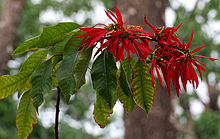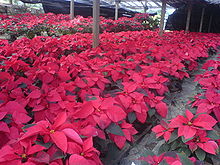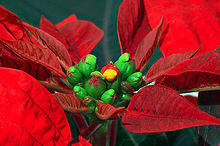- Euphorbia pulcherrima
-
"Poinsettia" redirects here. For other uses, see Poinsettia (disambiguation).
Euphorbia pulcherrima 
Scientific classification Kingdom: Plantae (unranked): Angiosperms (unranked): Eudicots (unranked): Rosids Order: Malpighiales Family: Euphorbiaceae Genus: Euphorbia Species: E. pulcherrima Binomial name Euphorbia pulcherrima
Willd. ex KlotzschEuphorbia pulcherrima, commonly known as poinsettia or noche buena, is a species of flowering plant indigenous to Mexico and Central America. The name "poinsettia" is after Joel Roberts Poinsett,[1] the first United States Minister to Mexico,[2] who introduced the plant into the US in 1825. It is also called the Atatürk flower in Turkey.
Contents
Description
 Leaves, bracts & flowers at Jayanti in Buxa Tiger Reserve in Jalpaiguri district of West Bengal, India.
Leaves, bracts & flowers at Jayanti in Buxa Tiger Reserve in Jalpaiguri district of West Bengal, India.
Euphorbia pulcherrima is a shrub or small tree, typically reaching a height of 0.6 to 4 m (2 to 16 ft). The plant bears dark green dentate leaves that measure 7 to 16 cm (3 to 6 inches) in length. The colored bracts—which are most often flaming red but can be orange, pale green, cream, pink, white or marbled—are actually leaves; because the flowers are unassuming and do not attract pollinators, brightly coloured leaves developed (aka bracts). The colors come from photoperiodism, meaning that they require darkness for 12 hours at a time for at least 5 days in a row to change color. At the same time, the plants need a lot of light during the day for the brightest color.[3]
Because of their groupings and colors, laymen often think the bracts are the flower petals of the plant. In fact, the flowers are grouped within the small yellow structures found in the center of each leaf bunch, and they are called cyathia.
The species is native to Mexico.[4] It is found in the wild in deciduous tropical forest at moderate elevations from southern Sinaloa down the entire Pacific coast of Mexico to Chiapas and Guatemala. It is also found in the interior in the hot, seasonally dry forests of Guerrero, Oaxaca, and Chiapas. Reports of E. pulcherrima growing in the wild in Nicaragua and Costa Rica have yet to be confirmed by botanists.[citation needed]
There are over 100 cultivated varieties of poinsettia available.
Christmas tradition
In Nahuatl, the language of the Aztecs, the plant is called Cuitlaxochitl (from cuitlatl, residue, and xochitl, flower) meaning "flower that grows in residues or soil." The Aztecs used the plant to produce red dye and as an antipyretic medication.[5] Today it is known in Mexico and Guatemala as "Noche Buena", meaning Christmas Eve. In Spain it is known as "Flor de Pascua", meaning "Easter flower". In both Chile and Peru, the plant became known as "Crown of the Andes".
The plant's association with Christmas began in 16th century Mexico, where legend tells of a young girl who was too poor to provide a gift for the celebration of Jesus' birthday. The tale goes that the child was inspired by an angel to gather weeds from the roadside and place them in front of the church altar. Crimson "blossoms" sprouted from the weeds and became beautiful poinsettias.[6] From the 17th century, Franciscan friars in Mexico included the plants in their Christmas celebrations.[7] The star-shaped leaf pattern is said to symbolize the Star of Bethlehem, and the red color represents the blood sacrifice through the crucifixion of Jesus.[8]
Poinsettias are popular Christmas decorations[1] in homes, churches, offices, and elsewhere across North America. They are available in large numbers from grocery, drug, and hardware stores. In the United States, December 12 is National Poinsettia Day.
Big Spring, Texas is well known for its poinsettias as the "lighted poinsettia capital". When the Comanche Trail Festival of Lights first began the dam at the big spring held four huge poinsettias made of rebar welded together in the shape of a poinsettia flower. Each flower was made up of 5 leaves. The leaves were decorated with red Christmas lights. The four poinsettia flowers were an awesome sight to see entering Big Spring from the south. Each year more flowers were added to the dam and inside the park until Comanche Trail Park has by 2006 added seven poinsettias, making a total of eleven lighted flowers on the dam and countless flowers inside the park, making Comanche Trail Park the Christmas Poinsettia capital.
American poinsettia monopoly
Until the 1990s, the Ecke family of Encinitas, California, had a virtual monopoly on poinsettias owing to a technological secret that made it difficult for others to compete. The Ecke family's key to producing more desirable poinsettias was to create a fuller, more compact plant, by grafting two varieties of poinsettia together. A poinsettia left to grow on its own will naturally take an open, somewhat weedy look. The Eckes' technique made it possible to get every seedling to branch, resulting in a bushier plant.[9]
Albert Ecke had emigrated from Germany to Los Angeles in 1900, opening a dairy and orchard in the Eagle Rock area. He became intrigued by the plant and sold them from street stands. His son, Paul Ecke, developed the grafting technique, but it was the third generation of Eckes, Paul Ecke, Jr., who was responsible for advancing the association between the plant and the winter holidays. Besides changing the market from mature plants shipped by rail to cuttings sent by air, he sent free plants to television stations for them to display on air from Thanksgiving to Christmas. He also appeared on television programs like The Tonight Show and Bob Hope's Christmas specials to promote the plants.[10]
However, in the 1990s, a university researcher discovered the method and published it, opening the door for competitors to flourish, particularly in Latin America where the cost of labor is far lower. The Ecke family, now led by Paul Ecke III, no longer grows any on farms in the U.S., but as of 2008, they still control about 70% of the domestic market and 50% of the worldwide market.[10]
Cultivation
In areas outside its natural environment, it is commonly grown as an indoor plant where it prefers good morning sun, then shade in the hotter part of the day. However, it is widely grown and very popular in subtropical climates such as Australia, North of Sydney.
As this is a subtropical plant, it will likely perish if the night-time temperature falls below 10 °C (50 °F) so is not suitable for planting in the ground in cooler climates. Likewise, daytime temperatures in excess of 21 °C (70 °F) tend to shorten the lifespan of the plant.[citation needed]
The poinsettia has also been cultivated in Egypt since the 1860s. It was brought from Mexico during the Egyptian campaign. It is called "Bent El Consul", "the consul's daughter", referring to the U.S. ambassador Joel Poinsett.[citation needed]
The poinsettia can be difficult to induce to reflower after the initial display when purchased. The plant requires a period of uninterrupted long, dark nights for around two months in autumn in order to develop flowers. Incidental light at night during this time will hamper flower production. When watering it is important to allow the plant to drain out any excess water. Having a poinsettia sit in water can do harm to the plant as it prefers moist soil to direct water.
In order to produce extra axillary buds that are necessary for plants containing multiple flowers, a phytoplasma infection – whose symptoms include the proliferation of axillary buds – is used.[11]
Diseases
Rumoured toxicity
In the United States and perhaps elsewhere, there is a common misconception that the poinsettia is highly toxic. This is not true; it is mildly irritating to the skin or stomach[4] and may sometimes cause diarrhea and vomiting if eaten.[12] Sap introduced into the human eye may cause temporary blindness.[13] An American Journal of Emergency Medicine study of 22,793 cases reported to the American Association of Poison Control Centers showed no fatalities, and furthermore that a strong majority of poinsettia exposures are accidental, involve children, and usually do not result in any type of medical treatment.[14] POISINDEX, a major source for poison control centers, says it would take 500 bracts for a 50-pound child to eat an amount found to be toxic in experiments.[15] An Ohio State University study showed no problems even with extremely large doses.[16]
The origin of this myth could be found in the fact that many plants of the spurge genus are indeed toxic.[citation needed] This misconception was spread by a 1919 urban legend of a two-year-old child dying after consuming a poinsettia leaf.[15] While it is true that the plant is not very toxic, those sensitive to latex may suffer an allergic reaction and it is therefore not advisable to bring the plants into the home of sensitive individuals.[17]
References
- ^ a b Bussell, Gene (Dec 2009). "Get Ready for Holiday Flowers". Southern Living 44 (12): 88.
- ^ Mexico
- ^ "How To Make Poinsettia Turn Red: Make A Poinsettia Rebloom". Gardening Know How. http://www.gardeningknowhow.com/exotic/how-to-make-poinsettia-turn-red-make-a-poinsettia-rebloom.htm. Retrieved 2010-01-28.
- ^ a b Bender, Steve, ed (January 2004). "Euphorbia". The Southern Living Garden Book (2nd ed.). Birmingham, Alabama: Oxmoor House. p. 306. ISBN 0-376-03910-8.
- ^ Poinsettia Facts
- ^ Flowers Ireland
- ^ The Legends and Traditions of Holiday Plants | Horticulture and Home Pest News
- ^ "'The Christmas Poinsettia' Fine Art Print by Anne Gitto". RedBubble. http://www.redbubble.com/people/anneg/art/4349110-1-the-christmas-poinsettia. Retrieved 2010-01-28.
- ^ Cynthia Crossen, "Holiday's Ubiquitous Houseplant," Wall Street Journal, December 19, 2000.
- ^ a b Anton, Mike (December 23, 2008). "The bloom is off the poinsettia business". Los Angeles Times. http://www.latimes.com/news/local/la-me-poinsettia23-2008dec23,0,899159.story. Retrieved 2008-12-28.
- ^ Lee et al. (1997) Phytoplasma induced free branching in commercial cultivars. Nature Biotechnology 15 178-182
- ^ "Are Poinsettia Plants Poisonous? Fact or Fiction?". http://www.medicinenet.com/script/main/art.asp?articlekey=55606. Retrieved 2007-12-21.
- ^ "Complete Poinsettia information from Drugs.com". http://www.drugs.com/npp/poinsettia.html. Retrieved 2008-11-29.
- ^ Krenzelok EP, Jacobsen TD, Aronis JM (November 1996). "Poinsettia exposures have good outcomes...just as we thought". Am J Emerg Med 14 (7): 671–4. doi:10.1016/S0735-6757(96)90086-8. PMID 8906768.
- ^ a b "snopes.com: Poisonous Poinsettias". http://www.snopes.com/holidays/christmas/poinsettia.asp. Retrieved 2008-12-16.
- ^ "Poinsettia Care in the Home". http://www.ecke.com/html/h_corp/corp_pntcare.html#poison. Retrieved 2010-01-28.
- ^ "Latex Allergy? Beware Poinsettias". WebMD. http://www.webmd.com/allergies/news/20031124/latex-allergy-beware-poinsettias. Retrieved 2010-01-28.
External links
- The Wild Poinsettia Page: Images of Euphorbia pulcherrima in the wild in Mexico
- Snopes on toxicity
- USDA PLANTS Database, Symbol EUPU9, E. pulcherrima Willd. ex Klotzsch
- Poinsettia pages at the University of Illinois, UIUC
- Poinsettia Q&A from Master Gardener Kris
- Poinsettias in Africa
- Ohio State University Fact Sheet.
- Poinsettia FAQ.
- Poinsettia at home.
- Hardingnursery
- History of Poinsettia Day
- Euphorbia Pulcherrima
Categories:- Euphorbia
- Flowers
- Flora of Central Mexico
- Christmas plants
- Christian folklore
- Mexican folklore
Wikimedia Foundation. 2010.


